Vector addition
Use this PhET simulation to explore vector addition.
Vectors are used to represent forces in physics, handle 2D and 3D manipulation with computer graphics, and to calculate the forces acting on materials in textiles. You also deal with vector quantities in your everyday life, from driving your car down the road to planning the shortest route to get to uni. Use this resource to gain a basic understanding of vectors.
A vector is a measurable quantity with direction. Examples of vectors are:
On the other hand, a scalar quantity has magnitude only, i.e. no direction. Examples include:
Vectors are shown using an arrow that points in specific direction. The length of the line indicates the magnitude of the vector–in other words, the longer the line, the greater the magnitude. This means that a force vector of \(10\textrm{ N}\) will be \(5\) times longer than a force vector of \(2\textrm{ N}\).
Vectors in three-dimensional space are defined by three directions that are perpendicular to each other. They can be denoted as bold letters or by using a vector arrow: \(\vec{a}\) or \(\vec{b}\) or \(\vec{c}\).
In the following figure, point P is the tail of the vector and point Q is the head of the vector. The vector is referred to as \(\overrightarrow{PQ}\), as the arrow points from point P to point Q.
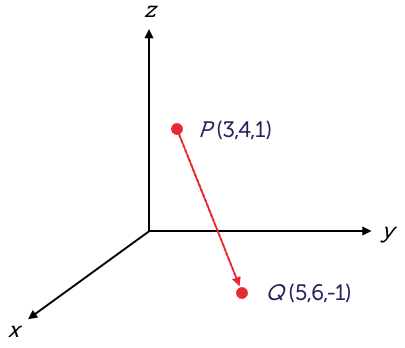
Vectors can also be defined along horizontal or vertical axes — that is, in two directions. A vector in the opposite direction from \(\vec{a}\) is denoted by \(-\vec{a}\).

In the diagram, the vector \(\vec{r}\) is represented by \(\overrightarrow{OP}\) where \(P\) is the point \((x,y,z)\). This is called a position vector, which indicates where the vector is relative to the origin \(O(0,0,0)\).
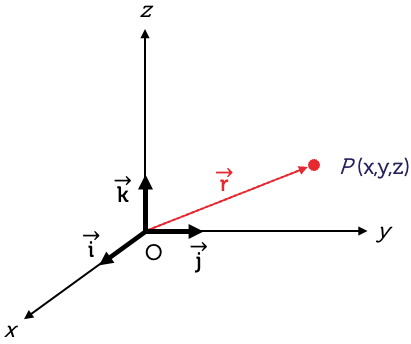
If \(\vec{i}\), \(\vec{j}\), and \(\vec{k}\) are vectors parallel to the positive directions of the \(x\)-, \(y\)- and \(z\)-axis, respectively, then:
\(\overrightarrow{OP}\) is then the position vector \(x\vec{i}+y\vec{j}+z\vec{k}\), and \(x\), \(y\) and \(z\) are called the components of the vector.
The notation \((x,y,z)\) is used to denote the vector \(\vec{r}=(x\vec{i}+y\vec{j}+z\vec{k})\), as well as the coordinates of a point \(P(x,y,z)\).
In the previous diagram, we defined vector \(P\) which extended from the origin O to point \(P(x,y,z)\). We can also define vectors extending from two points in space, such as from point \(P(x_{1},y_{1},z_{1})\) to point \(Q(x_{2},y_{2},z_{2})\).
\(\overrightarrow{PQ}\) is called a directed line segment or geometric vector. This vector is found by subtracting the coordinates of \(P\) (the initial point) from the coordinates of \(Q\) (the final point).
\[\overrightarrow{PQ}=(x_{2}-x_{1})\vec{i}+(y_{2}-y_{1})\vec{j}+(z_{2}-z_{1})\vec{k}\]
Let's consider the points \(P(3,4,1)\) and \(Q(5,6,-1)\).

When we apply the general formula:
\[\begin{align*} PQ & = (5-3)\vec{i}+(6-4)\vec{j}+(-1-1)\vec{k}\\
& = 2\vec{i}+2\vec{j}-2\vec{k}
\end{align*}\]
Therefore, the directed line segment \(\overrightarrow{PQ}\) is represented by the vector \(2\vec{i}+2\vec{j}-2\vec{k}\) or \((2,2,-2)\). This is also used to represent ANY directed line segment with the same length and direction as \(\overrightarrow{PQ}\).
The directed line segment \(\overrightarrow{QP}\) has the same length as \(\overrightarrow{PQ}\) but is in the opposite direction.
\[\begin{align*} \overrightarrow{QP} & = -\overrightarrow{PQ}\\
& = -(2\vec{i}+2\vec{j}-2\vec{k})\\
& = -2\vec{i}-2\vec{j}+2\vec{k}\quad\textrm{or}\quad(-2,-2,2)
\end{align*}\]
Vectors may be added or subtracted by adding or subtracting their corresponding components. For vectors pointing in the same direction, we simply place them head to tail and add them algebraically. Here, \(\overrightarrow{AB}+\overrightarrow{CD}=\overrightarrow{AD}\).

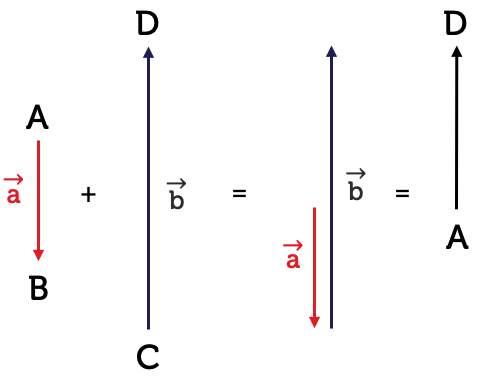
Let's consider two vectors: \(\vec{a}\) extends from point \(P\) to point \(Q\), and \(\vec{b}\) extends from point \(Q\) to point \(R\).
To add vectors \(\vec{a}\) and \(\vec{b}\), we place the tail of vector \(\vec{b}\) at the head of vector \(\vec{a}\) (point Q). The vector sum, \(\vec{a}+\vec{b}\), is the vector \(\overrightarrow{PR}\), from the tail of vector \(\vec{a}\) to the head of \(\vec{b}\).
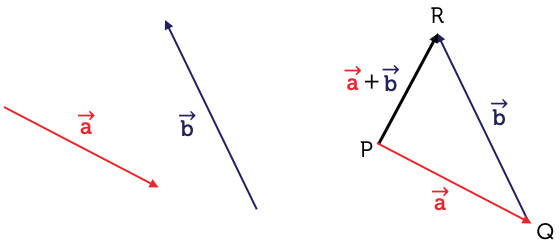
\(\vec{a}\) and \(-\vec{b}\) are added together. This means that \(\overrightarrow{PR}\) is the same as \(\vec{a}-\vec{b}\).
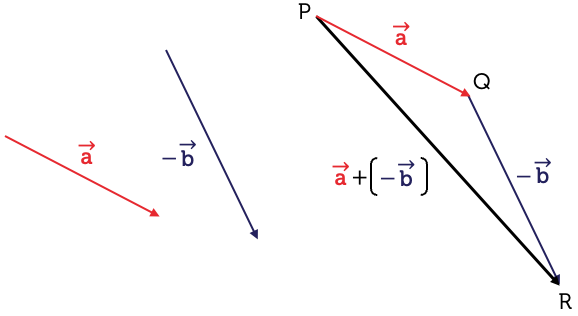
If \(\vec{a}=(-3,4,2)\) and \(\vec{b}=(-1,-2,3)\), find \(\vec{a}+\vec{b}\) and \(\vec{a}-\vec{b}\).
\[\begin{align*} \vec{a}+\vec{b} & = (-3,4,2)+(-1,-2,3)\\
& = (-3+(-1),4+(-2),2+3)\\
& = (-4,2,5)
\end{align*}\] \[\begin{align*} \vec{a}-\vec{b} & = (-3,4,2)-(-1,-2,3)\\
& = (-3-(-1),4-(-2),2-3)\\
& = (-2,6,-1)
\end{align*}\]
The two force vectors are \(\overrightarrow{F_{1}}=200\vec{i}+300\vec{j}+150\vec{k}\) in newtons and \(\overrightarrow{F_{2}}=-150\vec{i}+100\vec{j}+200\vec{k}\) in newtons. The graduate student has calculated the resultant force vector to be \(\overrightarrow{F_{R}}=50\vec{i}+400\vec{j}+350\vec{k}\). Is the student correct?
The student is correct.
Once again, let's consider vector \(P(x,y,z)\) where \(\vec{P}=x\vec{i}+y\vec{j}+z\vec{k}\). The length or magnitude of \(\vec{P}\) is denoted by \(\left|\vec{P}\right|\) or \('\vec{P}'\), where:
\[\left|\vec{P}\right|=\sqrt{x^{2}+y^{2}+z^{2}}\]
Take, for example, the vector \(2\vec{i}+3\vec{j}-5\vec{k}\). Its length is:
\[\sqrt{2^{2}+3^{2}+(-5)^{2}}=\sqrt{38}\]
Any vector with a magnitude of \(1\) is called a unit vector. If \(\vec{P}\) is any vector, then a unit vector parallel to \(\vec{P}\) is written \(\hat{P}\) (read as
The unit vector \(\hat{P}\) equals vector \(\vec{P}\) divided by its magnitude \(\left|\vec{P}\right|\).
\[\hat{P} = \frac{\vec{P}}{\left|\vec{P}\right|}\]
This can be rearranged to give:
\[\vec{P} = \left|\vec{P}\right|\hat{P}\]
The rearranged equation shows that vector \(P\) is the magnitude of the vector multiplied by its unit vector.
You should remember unit vectors \(\vec{i}\), \(\vec{j}\) and \(\vec{k}\), which are parallel to the \(x\)-, \(y\)- and \(z\)-axes, respectively. Sometimes, they are written as \(\hat{i}\), \(\hat{j}\) and \(\hat{k}\), especially when emphasising that the vectors have a magnitude of \(1\) and point in the positive directions.
If \(\overrightarrow{PQ}\) is the line \(2\vec{i}-5\vec{j}+\vec{k}\), find the unit vector parallel to \(\overrightarrow{PQ}\).
To find the unit vector, divide the vector by its magnitude. Let's calculate the magnitude first.
\[\begin{align*} \overrightarrow{PQ} & = \sqrt{2^{2}+\left(-5\right)^{2}+1^{2}}\\
& = \sqrt{30}
\end{align*}\] The unit vector parallel to \(\overrightarrow{PQ}\) is therefore:
\[\begin{align*} \overrightarrow{PQ} & = \frac{\overrightarrow{PQ}}{\left|\overrightarrow{PQ}\right|}\\
& = \frac{(2\vec{i}-5\vec{j}+\vec{k})}{\sqrt{30}}\\
& = \frac{1}{\sqrt{30}}(2\vec{i}-5\vec{j}+\vec{k})
\end{align*}\]
A scalar is a number that you multiply by to change the magnitude of a value. To multiply a vector by a scalar, \(m\), you just multiply each component by \(m\).
\[m\vec{P}=mx\vec{i}+my\vec{j}+mz\vec{k}\]
The result is a vector of length \(m\times\left|\vec{P}\right|\).
Two vectors, \(\vec{a}\) and \(\vec{b}\), are said to be parallel if and ONLY if \(\vec{a}=k\vec{b}\) where \(k\) is a real constant.
Multiply \(\vec{a}=(3\vec{i}+\vec{j}-2\vec{k})\) by \(7\) and show that \(\left|7\vec{a}\right|=7\left|\vec{a}\right|\).
To multiply by a scalar, multiply each component of the vector by the scalar.
\[\begin{align*} 7\vec{a} & = 7(3\vec{i}+\vec{j}-2\vec{k})\\
& = 21\vec{i}+7\vec{j}-14\vec{k}
\end{align*}\]
Now, let's find \(\left|7\vec{a}\right|\) and \(7\left|\vec{a}\right|\).
\[\begin{align*} \left|7\vec{a}\right| & = \sqrt{21^{2}+7^{2}+(-14)^{2}}\\
& = \sqrt{686}\\
& = \sqrt{49\times14}\\
& = 7\sqrt{14}
\end{align*}\] \[\begin{align*} \left|\vec{a}\right| & = \sqrt{3^{2}+1^{2}+(-2)^{2}}
& = \sqrt{14}\\
7\left|\vec{a}\right| & = 7\sqrt{14}
\end{align*}\]
Therefore, \(\left|7\vec{a}\right| = 7\left|\vec{a}\right| = 7\sqrt{14}\).
Images on this page by RMIT, licensed under CC BY-NC 4.0